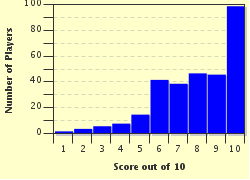Quiz Answer Key and Fun Facts
1. This extremely bright purple dye was discovered by accident in the 19th century by a chemist trying to synthesize quinine as a malaria cure.
2. What do you call a substance that fixes dye permanently in fabric?
3. Which of the following fabric dyes is not derived from an animal?
4. What somewhat repellant substance was traditionally used in dyeing by the weavers who make the coveted traditional Harris tweed in the Hebrides?
5. If I want to dye something a nice blue colour, I could use which of these?
6. A red, yellow or brown pigment derived from mud, metal, rock or earth would be a type of:
7. One of the earliest pigments used by prehistoric humans was carbon black. How was it obtained?
8. Murex was prized by the Romans (among other civilizations) for its rich colour - and only rich people were allowed to use it. What colour does it produce?
9. Craftspeople using a traditional dye technique of Asia and Africa paint wax onto fabric and then dye it. Because the wax resists the dye, it creates intricate colour patterns. What is this technique called?
10. How old are the rare examples of dyed fabric found near Jericho in Palestine?
Source: Author
SBH
This quiz was reviewed by FunTrivia editor
WesleyCrusher before going online.
Any errors found in FunTrivia content are routinely corrected through our feedback system.

